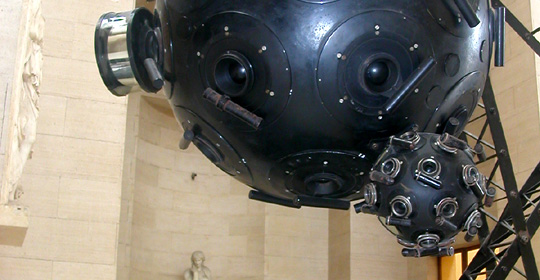History
The planetarium: from the Antikythera machine to modern projectors.
From the most ancient times our ancestors, based on their patient observations, tried to understand the movements of the stars, developing a clear and logical theory to explain them. One of the most fascinating representations of the sky are the heavenly globes, dating from classical times: the tradition attributes the construction of the first one to Anaximander of Miletus.


The Atlante Farnese is one of the oldest remaining globes. It was part of the collection of the Farnese family and is now in the Museo Archeologico di Napoli. It is a marble statue from the 2nd century AD depicting the Titano Atlante che sorregge sulle spalle un globo celeste, testified by sculptures in the low relief of the constellations, the eclittica, the equatore celeste and other references.
An enigma of the ancient world is represented by the famous Antikythera Machine, dated between the 1st century BC and the 3rd century AD. It was found in 1902 between the remains of an ancient wrecked ship near the coast of the island of Antikythera, between Greece and Crete. It was composed from four pieces of metal, showing the remains of what must have been an inventive mechanical system with several different components.
The astrolabe is certainly one of the oldest scientific instruments. It must have been constructed using a great technical and manual skill if Tolomeo and Ipparco, some of the greatest ancient astronomers, used this type of instrument to make most of their observations for their famous star catalogues.
A tool that comes from the astrolabe is the armillary sphere. This was also the work of Greek astronomers, but became very popular from the 15th century onwards. It was composed of a series of circles representing the main astronomical references including the celestial equator, the tropics, the Arctic and Antarctic polar circles and the ecliptic. In the centre was a sphere representing the Earth (in the geocentric system) or the Sun (in the heliocentric system).
In addition to the astrolabe and armillary spheres, clocks were built from the 13th century onwards that had little to do with timekeeping, but basically included the movement and representation of the planets. The first large public clocks in the 15th century resembled large planetariums. Famous is the one on the Prague City Hall, dating back to 1410, which indicated the beginning of the seasons and the relative movements of the Sun and the Moon, showing the phases of the Moon. In Italy, the first astronomical clock, reproducing the movements of the Sun and the Moon, was built in Padua in 1344 by Jacopo Dondi.
At the beginning of the 18th century, the table planetarium or 'orrery' was invented in England. The word first appeared in 1713 and is derived from the name of scientific instrument collector Charles Boyle, 4th Earl of Orrery. He had encouraged and facilitated the construction of this kind of instrument that reproduced the motion of the Sun, Earth and Moon.
Planetarium Projection
The most common image of the planetarium is a building dominated by a large hemispherical dome (or a large, profiled screen), where a specific instrument projects images of the stars and other heavenly objects, reproducing their movements. Other devices and technologies can be used to increase the immersive, visual and emotional experience of the spectator.
The "old" Planetarium of Rome
After the First World War (1915-18), Germany offered Italy a Zeiss planetarium as payment for the damage caused. At the time it was a brand new instrument that had been a great success with the German public. Thanks to the installation of that projector under the dome of the Aula Ottagona (at the Terme di Diocleziano), the Planetarium of Rome was inaugurated in 1928: it was the first to be built outside Germany. It was closed in the 1980s.
Twenty years ago, the historic Planetarium of Rome, located in the Sala della Minerva at the Terme di Diocleziano, was closed to the public.
The Planetarium of Rome was the first in Italy in terms of size and was well known and loved by the Romans and very popular with tourists. The sophisticated technology with which it was equipped (a Zeiss II projector) was highly advanced for its time and made it a state-of-the-art Planetarium in all of Europe.
The Planetarium and Museo Astronomico (2004-2014)
After a long period of closure, the Planetarium returned in Rome in 2004, thanks to an important installation inside the Museo della Civiltà Romana, offering both a Planetarium and a Museo Astronomico. A 14-metre-diameter dome is installed in a hall of about 300 square metres, with 98 ergonomic armchairs mounted in concentric rows beneath it. In the centre is the SN 95 optical projector from the French company R.S.A., which also uses a digital channel on three video projectors, 12 diaprojectors and a multi-channel audio system. The Museo Astronomico next to the Planetarium is a structure that completes the cultural offer, outside the usual exhibition standards. Models, interactive stations and dioramas allow the visitor to truly experience space, living science without losing the possibility to be surprised and excited. The intense activity of the Planetarium and the Museo Astronomico in this last ten years is demonstrated by the numbers that certify it: an annual audience of approximately 100,000 visitors and almost one million in ten years, which have placed it for several years in the top ten of the most visited Italian science museums, according to the Touring Club Italiano dossier. Thousands of shows for the public and schools, hundreds of events, prestigious guests from the Italian and international scientific scene, and an offer of almost 70 live productions make it unique in the international arena.
In 2014 the Museo della Civiltà , the Planetarium and the Museo Astronomico were closed temporarily for important works to restore the whole site. The Planetarium's activities continue in various locations (Villa Torlonia, Ex Dogana, Museo Civico di Zoologia), also thanks to various events and projects throughout the City of Rome, in advance of the reopening of the Eur site.


































